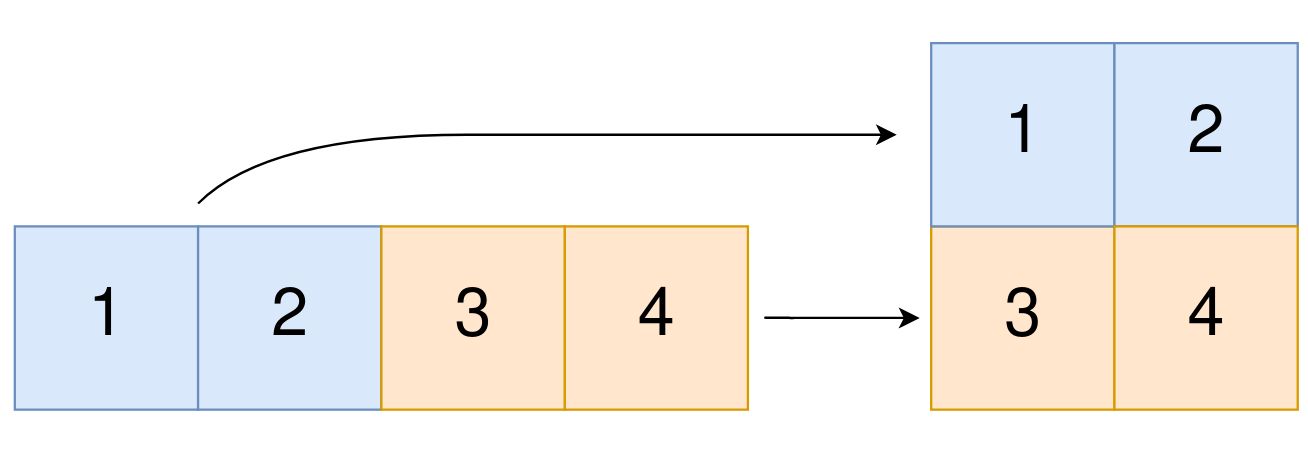|
| 1 | +# [2022. Convert 1D Array Into 2D Array](https://leetcode.com/problems/convert-1d-array-into-2d-array/) |
| 2 | + |
| 3 | +## 题目 |
| 4 | + |
| 5 | +You are given a **0-indexed** 1-dimensional (1D) integer array `original`, and two integers, `m` and `n`. You are tasked with creating a 2-dimensional (2D) array with `m` rows and `n` columns using **all** the elements from `original`. |
| 6 | + |
| 7 | +The elements from indices `0` to `n - 1` (**inclusive**) of `original` should form the first row of the constructed 2D array, the elements from indices `n` to `2 * n - 1` (**inclusive**) should form the second row of the constructed 2D array, and so on. |
| 8 | + |
| 9 | +Return *an* `m x n` *2D array constructed according to the above procedure, or an empty 2D array if it is impossible*. |
| 10 | + |
| 11 | +**Example 1:** |
| 12 | + |
| 13 | + |
| 14 | + |
| 15 | +``` |
| 16 | +Input: original = [1,2,3,4], m = 2, n = 2 |
| 17 | +Output: [[1,2],[3,4]] |
| 18 | +Explanation: The constructed 2D array should contain 2 rows and 2 columns. |
| 19 | +The first group of n=2 elements in original, [1,2], becomes the first row in the constructed 2D array. |
| 20 | +The second group of n=2 elements in original, [3,4], becomes the second row in the constructed 2D array. |
| 21 | +
|
| 22 | +``` |
| 23 | + |
| 24 | +**Example 2:** |
| 25 | + |
| 26 | +``` |
| 27 | +Input: original = [1,2,3], m = 1, n = 3 |
| 28 | +Output: [[1,2,3]] |
| 29 | +Explanation: The constructed 2D array should contain 1 row and 3 columns. |
| 30 | +Put all three elements in original into the first row of the constructed 2D array. |
| 31 | +
|
| 32 | +``` |
| 33 | + |
| 34 | +**Example 3:** |
| 35 | + |
| 36 | +``` |
| 37 | +Input: original = [1,2], m = 1, n = 1 |
| 38 | +Output: [] |
| 39 | +Explanation: There are 2 elements in original. |
| 40 | +It is impossible to fit 2 elements in a 1x1 2D array, so return an empty 2D array. |
| 41 | +
|
| 42 | +``` |
| 43 | + |
| 44 | +**Constraints:** |
| 45 | + |
| 46 | +- `1 <= original.length <= 5 * 104` |
| 47 | +- `1 <= original[i] <= 105` |
| 48 | +- `1 <= m, n <= 4 * 104` |
| 49 | + |
| 50 | +## 题目大意 |
| 51 | + |
| 52 | +给你一个下标从 0 开始的一维整数数组 original 和两个整数 m 和 n 。你需要使用 original 中 所有 元素创建一个 m 行 n 列的二维数组。 |
| 53 | + |
| 54 | +original 中下标从 0 到 n - 1 (都 包含 )的元素构成二维数组的第一行,下标从 n 到 2 * n - 1 (都 包含 )的元素构成二维数组的第二行,依此类推。 |
| 55 | + |
| 56 | +请你根据上述过程返回一个 m x n 的二维数组。如果无法构成这样的二维数组,请你返回一个空的二维数组。 |
| 57 | + |
| 58 | +## 解题思路 |
| 59 | + |
| 60 | +- 简单题。从一维数组 original 中依次取出每行 n 个元素,顺序放到 m 行中。此题中,如果 m*n 大于或者小于 original 的长度,都输出空数组。 |
| 61 | + |
| 62 | +## 代码 |
| 63 | + |
| 64 | +```go |
| 65 | +package leetcode |
| 66 | + |
| 67 | +func construct2DArray(original []int, m int, n int) [][]int { |
| 68 | + if m*n != len(original) { |
| 69 | + return [][]int{} |
| 70 | + } |
| 71 | + res := make([][]int, m) |
| 72 | + for i := 0; i < m; i++ { |
| 73 | + res[i] = original[n*i : n*(i+1)] |
| 74 | + } |
| 75 | + return res |
| 76 | +} |
| 77 | +``` |
0 commit comments